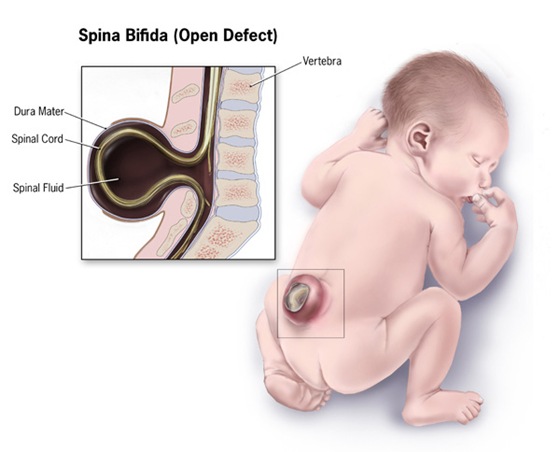Spina bifida, literally translated from Latin to “split spine” is a neural tube birth defect that is characterized by incomplete closure of the spinal cord. It can lead to symptoms such as loss of sensation and paralysis of the legs, the severity depending on the location and extent of the opening.
There are three main types of spina bifida: spina bifida occulta, meningocele and myelomeningocele. Some patients with spina bifida may not experience significant symptoms, such as those with less severe types, whereas others can have substantial differences in life expectancy and quality of life.

Spina Bifida Occulta
Occulta is the Latin word for hidden and indicates the mildest and most common form of spina bifida, which affects approximately 5-20% of the population. In most cases, it involves the incomplete closure of the outer part of some vertebrae, small enough in size for the spinal cord to be contained and not protrude.
Topical signs of this type of spina bifida at the skin site may include:
- Hair growth
- Dimple
- Birthmark
However, most patients with spina bifida occulta are asymptomatic and may not be aware that they are affected by the condition. People with spina bifida occulta do not appear to be affected by back pain to a greater extent than the general population.
Meningocele
Meningocele is the rarest type of spina bifida and refers to the normal development of the vertebrae with the growth of meninges in the spaces between the vertebrae. As a result, there is minimal damage to the spinal cord and patients do not usually experience chronic health problems related to the birth defect. However, some patients have reported symptoms of a tethered spinal cord, such as lower back pain, abnormal gait and scoliosis.
The main causes of meningocele are Currarino syndrome and tumors of the sacrococcyx and presacral space, such as teratoma.
Myelomeningocele
This type of spina bifida is the most severe and is more likely to result in complications, thus commonly requires treatment to manage the condition. It involves the protrusion of the spinal cord through the opening in the spinal column, leading to the formation of a sac around the external section with meningeal membranes.
As a result of the protrusion of the spinal cord, there are commonly some developmental problems or damage to the area, which can lead to symptoms of paralysis or loss of sensation. The severity of these symptoms depends on the extent and location of the protrusion; more severe cases are seen in patients with cranial defects.
A specific form of myelomeningocele, myeloschisis, is characterized by the presence of nervous tissue external of the spinal column with no closed membrane or sac. This exposes the nervous tissue to the surroundings and increases the risk of serious infections like meningitis.
Epidemiology
Spina bifida occulta is the most common type of spina bifida, which affects 5-20% of the population, depending on the location and research methods of the study. Other types of spina bifida are rarer, ranging from 0.1 to 5 infants per 1000 births. It appears that both geographical location and ethnic origin may have an effect on the risk of spina bifida, due to the great variance in incidence in different studies.
References
Further Reading
Last Updated: Apr 9, 2021